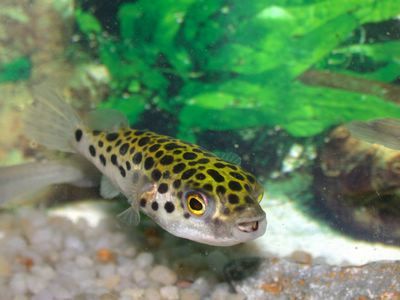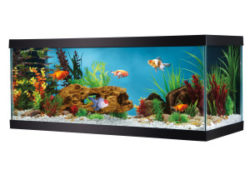Freshwater Puffers in the Home Aquarium
The following article is devoted to Freshwater Puffers in the Home Aquarium. Many people fall in love with puffer fish the minute they see them. There is more than meets the eye with these cute fish though, as they can be challenging to keep.

When aquarium enthusiasts first see freshwater puffers at a pet store, it is often love at first sight. Puffers, though, require more care than the average freshwater community fish. Here we will look at the characteristics and care requirements of the most common freshwater puffers, namely, the green spotted, figure eight, and dwarf, or yellow, puffer fish.
General Care
Puffer fish are tropical fish and prefer temperatures around 25º C. These fish have tough, leathery skin, and are covered with barely visible spines. These fish will “puff up” when under stress, but should not be purposely harassed. These fish are not at all shy, and rarely show any fear towards their keepers. Therefore, puffers have to be under so much stress to fully inflate themselves, that they may become injured if purposely frightened.
The skin of puffers is mildly toxic. Carbon should be changed regularly in a puffer tank, and frequent water changes are essential. Some aquarists recommend changing up to 50% of the water every 10 days. If a puffer dies in a tank, it should be removed immediately, as the toxins released by their skin can kill everything else in the aquarium.
Green Spotted Puffer
Green puffers are commonly described as freshwater fish, but in actuality, they thrive in brackish water. This means they require at least one tablespoon of salt (aquarium salt, with marine salt being better) per 5 gallons of water. To be exact, they require a specific gravity of 1.005 to 1.008. A specific gravity meter to measure salt levels in aquarium water can be purchased from most reputable aquarium stores.
Green spotted puffers have sharp, plate-like teeth. Even though they are cute, they will make short work of the fins of community fish. Green spotted puffers may even attack each other, so they are best suited to species aquariums of 2-3 puffers, if not kept alone. If you want to mix a green spotted puffer with other fish, add them with equally boisterous species, though this is not recommended.
Green spotted puffers grow to be 10-15 cm, and appreciate a well planted aquarium. Not all plants fare well in a brackish fish tank, so the safest bets are Java Fern and Anubias.
Green spotted puffers can not survive on pellet or flake food alone. They need small snails (the size of their eye), frozen foods (brine shrimp, blood worms, and krill), and live ghost shrimp to thrive. Freeze dried foods are good alternatives, but should not be fed exclusively.
Figure Eight Puffer
These fish only grow to 6 cm, but are just as aggressive, if not more so, then the green spotted puffer. It is controversial as to whether the figure eight puffer requires salt or not, as they tend to fare well in completely fresh water. A teaspoon or two of salt in the aquarium is probably beneficial though, as this helps replenish the electrolytes of any fish.
Figure eight puffers share the same feeding and compatibility requirements as the green spotted puffer, but tend to get less active and more belligerent with age. It is best to keep them in a species aquarium of 25 gallons of 2-3 fish, or solitarily in a tank of at least 15 gallons.
Dwarf or Yellow Puffer
In contrast to other puffers, these fish are truly freshwater fish, and will not tolerate salt. Dwarf puffers only reach a size of 2.5 cm, so can thrive in smaller tanks. These fish appreciate a well planted aquarium, and like aggregating around pieces of driftwood.
Dwarf puffers should be kept in a species aquarium, as they may nip the fins of community fish. Dwarf puffers can be kept together, but if more than one is kept, a tank of 20 gallons or more is recommended. Keeping one male per 2-3 females is best, as males get competitive, and may fight to the death.



